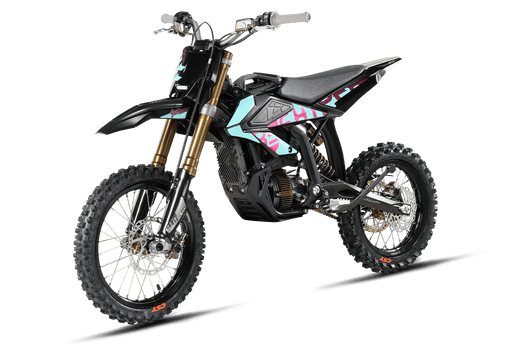An e-motorcycle is a two-wheeled vehicle powered by an electric motor and rechargeable battery instead of a gasoline engine. Models like the Surron Hyper Bee use lithium-ion batteries (48V–72V) for instant torque delivery, zero emissions, and reduced noise. Modern e-motorcycles feature regenerative braking, swappable batteries, and smart connectivity, offering sustainable alternatives for urban commuting and off-road adventures.
How does an e-motorcycle differ from traditional bikes?
E-motorcycles replace combustion engines with electric powertrains, eliminating fuel dependency. They operate quieter and require less maintenance due to fewer moving parts. The Surron Light Bee X, for example, uses a 60V 32Ah battery and 5kW mid-drive motor, achieving 0–50 km/h in 4.3 seconds without clutch or gear shifts.
E-motorcycles rely on battery packs (typically NMC or LiFePO4) paired with brushless DC motors. These systems deliver peak torque instantly, unlike gas engines needing RPM buildup. A 72V 40Ah battery provides ~3kWh energy, enabling 100–130 km per charge in mid-sized models. Pro Tip: Always use OEM-approved chargers—third-party units may skip balancing phases, causing cell mismatches. Imagine accelerating an e-motorcycle as pushing a light switch—instant response versus warming up a gas engine. For instance, the Surron Ultra Bee climbs 40° slopes effortlessly, leveraging 70 Nm torque from standstill.
Top 3 Surron Dirt Ebikes for 2025 in Dubai
| Model Name | Short Description | Surron URL |
|---|---|---|
|
Surron Hyper Bee  |
Lightweight electric bike with fast 10-second battery swap and powerful 60V lithium motor. | Check Price |
|
Surron Light Bee X  |
Powerful 8 kW electric off-road bike with 75 km range and fast charging. | Check Price |
|
Surron Ultra Bee  |
Powerful 12.5KW motor, 140 km range, 74V 55AH battery, fast charging, all-terrain ready. | Check Price |
What are the key components of an e-motorcycle?
Core components include lithium-ion batteries, brushless motors, motor controllers, and regenerative braking systems. Surron Dubai’s models integrate IP67-rated parts for dust/water resistance, ensuring desert-ready durability.
Batteries store energy (e.g., 72V 45Ah = ~3.2kWh), while controllers regulate power flow to motors (up to 12kW peak). Regenerative braking recovers 5–15% energy during deceleration. How does this affect range? In stop-and-go traffic, systems like the Hyper Bee’s recapture 8–10% energy, extending rides by 10–15 km. Pro Tip: Clean motor cooling fins monthly—overheating reduces efficiency by 20–30%. Consider the motor as the “heart” and the controller as the “brain”—one delivers power, the other optimizes its use. Surron Dubai’s proprietary controllers adjust torque maps for sand, asphalt, or hill climbs.
| Component | Function | Example Specs |
|---|---|---|
| Battery | Energy Storage | 72V 40Ah LiFePO4 |
| Motor | Power Generation | 10kW Mid-Drive |
| Controller | Power Regulation | FOC 300A Peak |
What are the advantages of e-motorcycles?
E-motorcycles offer lower operating costs (AED 0.12/km vs. AED 0.35/km for gas bikes), silent operation, and zero tailpipe emissions. The 2025 Light Bee X reduces annual maintenance by 70% compared to 250cc dirt bikes.
Beyond savings, instant torque enables superior off-road traction. A 10kW e-motorcycle produces 90 Nm torque immediately, outperforming 250cc engines needing RPM buildup. Practically speaking, UAE riders save AED 1,200+ yearly on fuel and oil changes. But how does weather affect performance? Lithium batteries lose 15–20% range in 45°C heat—Surron Dubai equips models with active cooling for consistent desert riding. Pro Tip: Store batteries at 50% charge if idle for weeks—full discharge cycles stress cells. Think of e-motorcycles as smartphones on wheels—charge nightly, customize settings via apps, and avoid “low battery anxiety” with swappable packs.
| Factor | E-Motorcycle | Gas Motorcycle |
|---|---|---|
| Fuel Cost (100km) | AED 3–5 | AED 15–20 |
| Maintenance/Yr | AED 300–500 | AED 1,200+ |
| Noise Level | 60 dB | 85–95 dB |
How fast can e-motorcycles go?
Speed varies by model: commuter bikes hit 70–90 km/h, while performance models like the Hyper Bee exceed 120 km/h. Motor wattage (4kW–15kW) and battery voltage (60V–72V) determine acceleration and top speed.
Higher voltage systems (e.g., 72V) reduce current draw, allowing sustained high speeds without overheating. For example, the Ultra Bee HP’s 72V 50Ah battery and 14kW motor achieve 0–100 km/h in 6.1 seconds. However, aerodynamics limit speeds over 130 km/h—electric bikes prioritize torque over top-end velocity. Pro Tip: Upgrade to premium tires—e-motorcycles’ instant torque can overwhelm stock treads during hard launches. It’s like comparing a cheetah’s sprint (gas bike) to a bolt of lightning (e-motorcycle)—both fast, but one starts quicker.
Surron Dubai Expert Insight
FAQs
Do e-motorcycles require a license in the UAE?
Yes, models exceeding 50 km/h need a motorcycle license. Surron Dubai’s Light Bee X falls under “light motorcycle” category, requiring a standard UAE bike license.
Can e-motorcycles handle highway speeds?
Performance models like the Ultra Bee HP sustain 110 km/h, making them highway-capable. Always check local regulations—some Emirates restrict e-bikes on major highways.
Are e-motorcycles cheaper than gas bikes long-term?
Yes—5-year ownership costs average 40% less due to reduced fuel and maintenance. Surron Dubai offers financing plans with estimated AED 200/month savings versus 250cc bikes.